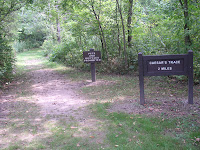“The spirits of the air live in the smells
Of fruit; and Joy, with pinions light, roves round
The gardens, or sits singing in the trees.”
Thus sang the jolly Autumn as he sat,
Then rose, girded himself, and o’er the bleak
Hills fled from our sight; but left his golden load.
- William Blake (Poetical Sketches)
Of fruit; and Joy, with pinions light, roves round
The gardens, or sits singing in the trees.”
Thus sang the jolly Autumn as he sat,
Then rose, girded himself, and o’er the bleak
Hills fled from our sight; but left his golden load.
- William Blake (Poetical Sketches)
A week ago I spent a glorious mid-week (one of the best days of the year) on a walk practically in my backyard in one of the metroparks created and managed by the Montgomery County, Ohio parks department. The county, which neighbors mine, has some excellent moderate hiking areas as well as biking (if you are interested).
This particular day, I traveled to Germantown Metropark in southern Montgomery County near the town of Germantown.

That village is a historic area that was founded by a migratory group of (what else?) Germans who settled the area having traveled from Pennsylvania. Germantown Metropark is probably the best of the county's park system for hikers. There is almost a little of everything for the backpacker (including camping). The park straddles a very clean Twin Creek and ties into the Twin Valley Trail which is south of Germantown. The main metropark itself has nearly 14 miles of hiking trails through spectacular scenery. There are ravines, large mature trees, wildflowers and steep topography making these trails sometimes a challenge to regular backpackers. You'll also see fabulous grassland prairies, ponds, dry hillside prairies and assorted flora and fauna.
I traveled there, as I mentioned, in mid-week and right at the end of the fall leaf spectacular. The place was practically my own as the shorter four mile hike I took I nary met a one on the trail. The trail itself wound up and down the ravines and was at times hard to follow due to excessive leaf fall. Luckily, they have carefully marked points so you will know you are still on the correct trail.
I traveled an area that is part of the Twin Valley Trail, though I was still north and west of Germantown. I began just off Old Mill Road where I parked and began the hike south toward State Route 725. It is a two mile hike to that point and then looping back, the repeat two miles makes for a couple hour walk especially if you regularly stop to enjoy the sites.

At the point of the Old Mill Road, walk about 100 feet to the picnic tables that are there before you begin your hike and look at the Germantown dam and spillway. It was built around 1920 after the devastating 1913 flood. If you travel through Germantown heading west to Conservancy Road, you'll actually drive over the dam and be able to see its highpoint view before arriving at the parking point.
The hike begins at this point and if you travel up the ridge, it begins almost immediately to wind to and fro as you traverse gradually up the ridge. This area displays younger trees and thin coverage, but definite isolation.

The trail is a small backpack trail scraped out and generally smooth walking though with lots of uphill climbing. Gradually you reach a highpoint where it gradually begins to take you back down toward Twin Creek. Were it not for the markers or without a GPS or compass, it would be easy to get waylaid.
There were times that the woods increased in density and it was during this time that I heard some snapping of twigs. Turning I could see three deer making their way toward food? home? I must have been downwind form them because I thought I was rather noisy until I heard them and instead of me, it was the sudden cry of a bird that spooked them onward.
As you find that you are gradually working your way back into the bottom lands toward the creek, the pace quickens. The trail eventually takes you creekside into a calm, quiet area where the clear creek passes. It is said the creek is clean enough to be able to drink from safely. Agreements have been made with landowners to limit their agricultural uses. And while they recommend the water first be boiled, it can be used. When I was there, the creek was very low, and even though it is regulated by the dam, water levels have been low in the area.
Once more the trail begins to take you back to the top of the ridge in even denser woods as the trail meanders through before you reach the area where backpackers can camp for the night if desired.
This is final 1/2 mile or so of the hike before reaching State Route 725. The trail continues to wind its way down until

suddenly you are in the bottoms and the area opens into a vast field of prairie grass. When I was there, the sound of an eagle hovered overhead as it searched for its prey. The rest of the hike up to the road transition to Twin Valley Metropark where the trail continues is flat but tall grassland with the creek to your right. I continued on until I could begin to hear the sound of the vehicles passing along the road. At that point, I turned around and retraced my steps back to my car for a total hike of 4 miles.
I was only touching the beginning of this rather vast parkland and I was not in the best of it. That is to come another day. Perhaps, I'll try it first as an early winter experience returning later again in the Spring of a new year.












































